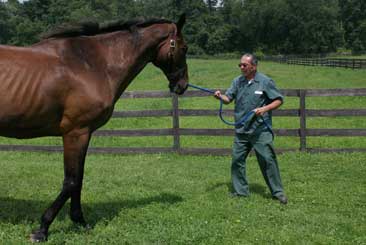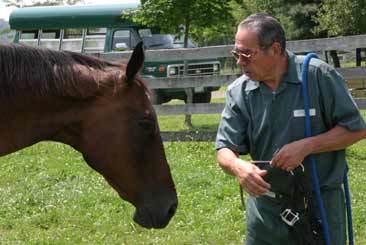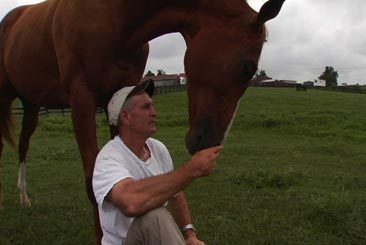|
|
| Back on the right track |
| By Ann Coppola, News Reporter |
| Published: 11/26/2007 |
 When the glory of their racing days are over, not every thoroughbred gets to retire to greener pastures. Some horses are neglected and abused, making them frightened, aggressive, and untrusting animals. These former kings of the racetrack need a caring hand to nurse them back to health. At Wateree River Correctional Institute in South Carolina, they’re receiving that care, and in the process, helping inmates heal from their own troubled pasts.
When the glory of their racing days are over, not every thoroughbred gets to retire to greener pastures. Some horses are neglected and abused, making them frightened, aggressive, and untrusting animals. These former kings of the racetrack need a caring hand to nurse them back to health. At Wateree River Correctional Institute in South Carolina, they’re receiving that care, and in the process, helping inmates heal from their own troubled pasts.Those working in the Wateree horse program receive intensive vocational training in every aspect of horse and barn care and management. Wateree has graduated close to 30 inmates since the start of the program in 2005. The facility’s barn, which was built by inmates in 2004, is currently home to 32 horses. “We teach the inmates how to be a groom and care for the horses,” Wateree Warden Joel Anderson says. “We teach some minor medical work, how to keep the brushes clean, and makes sure the horse is on the right schedule. The inmates are tested on skills like draping legs, taking temperatures, and checking joints for aches and pains.” The animals come to Wateree through the Thoroughbred Retirement Foundation (TRF), a non-profit organization that provides dignified, lifetime retirement for thoroughbreds. Many racehorses are not humanely dealt with once their owners no longer need them. They can even be killed at a young age for their meat. TRF has rescued hundreds of horses after their racing days have ended. “The program is designed not only for the horse to get a second chance, but for the inmate to get a second chance,” adds Anderson. The TRF partnership with correctional facilities began in 1984 at Wallkill State Correctional Facility in New York. In exchange for land use and labor, TRF designs and implements the vocational training program in equine training and management. Today, it has about 450 horses in seven correctional facilities across the U.S. “Thoroughbreds in particular are finely bred and a more sensitive breed of horses,” says TRF executive director Diana Pikulski. “They are a perfect animal for teaching people about themselves, and teaching people how to work out the problems within themselves that make it difficult for them to live in society.”  “Some inmates come into the system a lot like the horses do,” Anderson explains. “There’s built in aggression. When the horse first comes in he’s leery, standoffish, and he doesn’t understand his surroundings. The inmates are almost the same way. When we put the inmates and horses together they both learn. The inmates learn if I do right thing the horse won’t hurt me, the horse learns if I do the right thing the inmate won’t harm me. They actually form a bond.” The bond Anderson notices is part of an entire area of scientific research called equine assisted psychotherapy. The practice involves teaching people to work with horses in a way that will encourage emotional growth and learning. “If you approach a horse, whether it’s in a stall or in a field, and your body has tension in it or even the slightest bit of anger or aggression, that horse is going in the other direction,” Pikulski explains. “You can’t call to a horse and make it stand there. It’s not like a dog that you can give command cues to. The only way it’s going to respond is if you relax your body and you deal with whatever is going on in your head that’s making you tense or angry.” The program helps the horses as well, who often suffer from devastating injuries at the time of their retirement. “They’re only two or three years old, and after so much racing, their long, spindly legs now have torn ligaments and shattered bones. So the inmates really have to nurse them back to health and retrain them,” says Sheri Bylander, who is making a documentary, due out in 2008, about TRF’s work in correctional facilities. While filming, Bylander was also struck by the unusual similarity and bond the inmates and horses share. “When the inmates see the animal thrown away, it’s almost like society gets them out of sight, out of mind,” Bylander says. “They see a lot of themselves in that, and the dynamic that develops between the horse and inmate just amazes me.” Not only do the inmates form a life changing relationship, but also they learn marketable skills they can use after release.  “In addition to the emotional and mental benefits, the vocational training program teaches inmates about the horse’s anatomy, about feeding, digestion, and proper nutrition and care,” Pikulski adds. “That is a marketable skill in the horse business, which is just huge right now.” Of course, such specialized offender programming comes at a cost. “Generally, we like the sites we choose to have a minimum of 50 acres of pasture,” Pikulski says. “This allows us to have plenty of turn out for at least 25 horses. Depending on the site, it may only take $10,000 to $30,000 to renovate it for horses and for teaching the inmates. If there are no farm buildings, we may need to raise more like $100,000 to build a state of the art facility.” For Anderson, it’s been a price worth paying. “It’s a win-win for us because very few of our inmates that work out there get in any trouble once they go on to graduate,” he says. “It’s kind of a give and take on both sides. The inmate has to learn patience, and the horse has to learn patience. In today’s corrections industry, not many inmates have patience. It really works out well. It’s a nice place, and a great program for Wateree.” These programs are continuing to grow, with states like Tennessee and Georgia considering similar ones. For Wateree and all the other correctional facilities that may serve as the new home of a retired racing horse, the program remains a meaningful way to help both inmates and horses get their lives back on track. Related Resources: Learn about where TRF works Visit the Equine Assisted Growth and Learning Association More facts about thoroughbreds More about Bylander’s documentary Photographs courtesy of Mim Adkins |
MARKETPLACE search vendors | advanced search

IN CASE YOU MISSED IT
|


Comments:
No comments have been posted for this article.
Login to let us know what you think